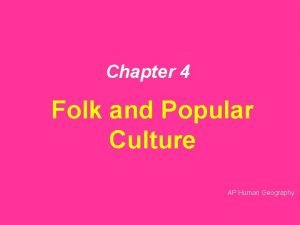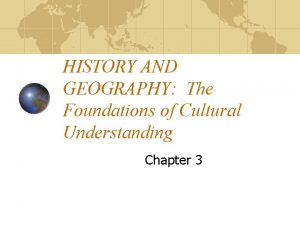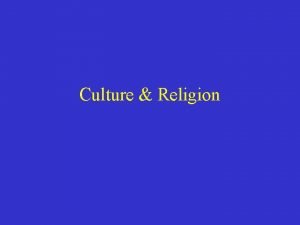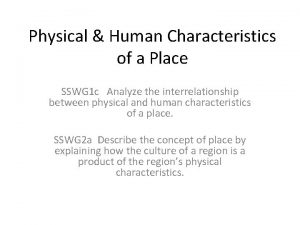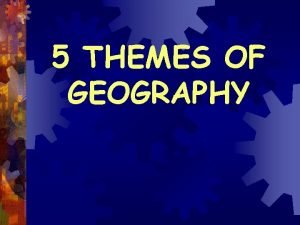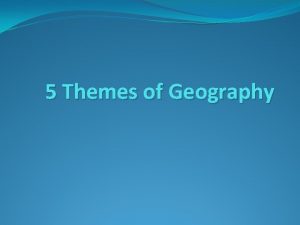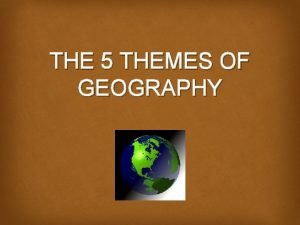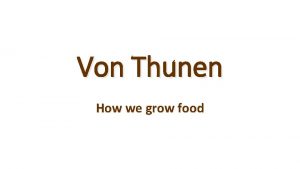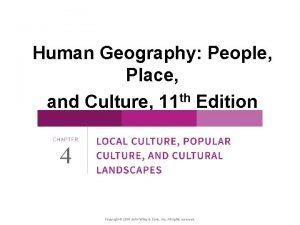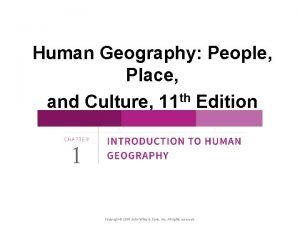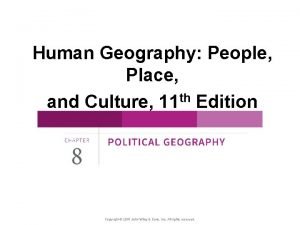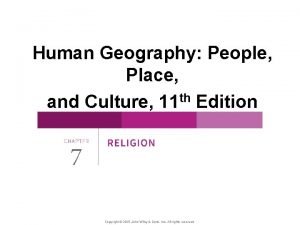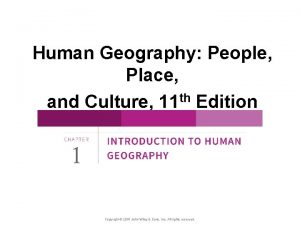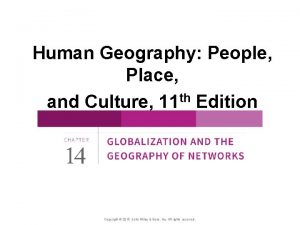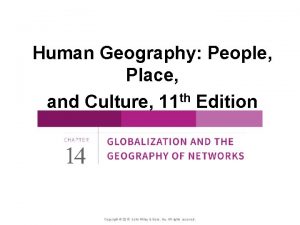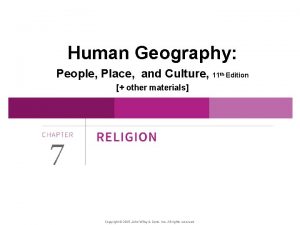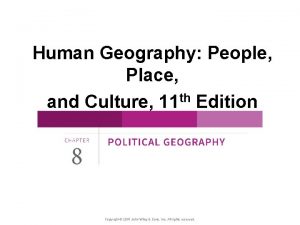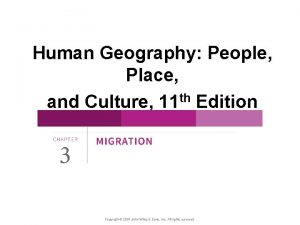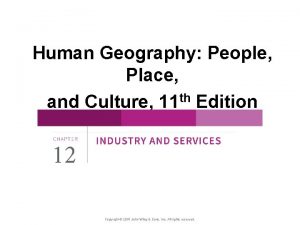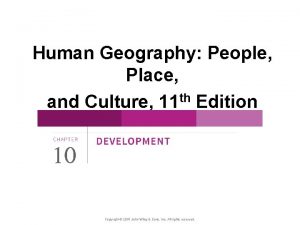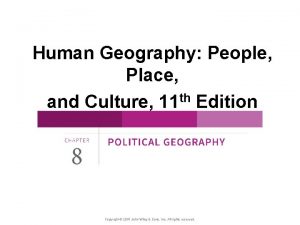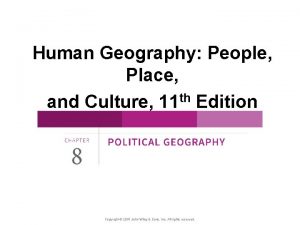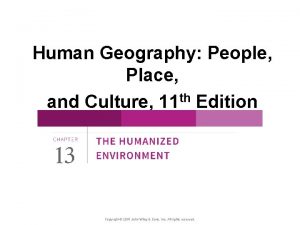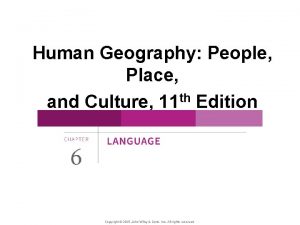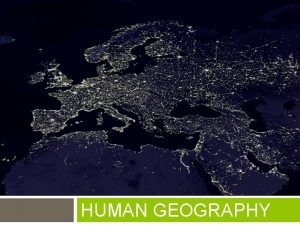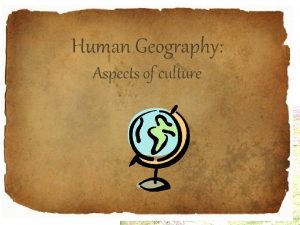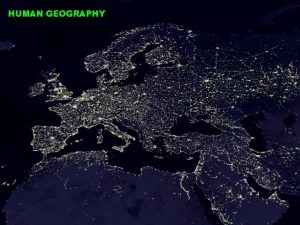Human Geography People Place and Culture 11 th





































- Slides: 37

Human Geography: People, Place, and Culture, 11 th Edition Copyright © 2015 John Wiley & Sons, Inc. All rights reserved.

Chapter 3: Migration Copyright © 2015 John Wiley & Sons, Inc. All rights reserved.

Key Question: What is migration? • Movement is inherently geographical. • All movement involves leaving home. • Three types of movement: 1. Cyclic 2. Periodic 3. Migration Copyright © 2015 John Wiley & Sons, Inc. All rights reserved.

Cyclic Movement • Involves journeys that begin at our home base and bring us back to it • Regular sequences of short moves within a local area = activity spaces • Commuting • Seasonal movement • Nomadism Copyright © 2015 John Wiley & Sons, Inc. All rights reserved.

Periodic Movement • Involves a longer period of time away from the home base than cyclic movement • Migrant labor • Transhumance, a system of pastoral farming where ranchers move livestock according to the seasonal availability of pastures • College attendance • Military service Copyright © 2015 John Wiley & Sons, Inc. All rights reserved.

Migration • Permanent relocation across significant distances • International migration/Transnational migration Emigrant = migrates out of country Immigrant = migrates into country • Internal migration varies according to the mobility of the population. Copyright © 2015 John Wiley & Sons, Inc. All rights reserved.

Copyright © 2015 John Wiley & Sons, Inc. All rights reserved.

Choose one type of cyclic or periodic movement and then think of a specific example of the kind of movement you chose. Now, determine how this movement changes both the home and the destination as a result of this cyclic or period movement. Copyright © 2015 John Wiley & Sons, Inc. All rights reserved.

Key Question: Why do people migrate? Forced Migration • Atlantic slave trade: the largest and most devastating forced migration in the history of humanity • Human Trafficking Copyright © 2015 John Wiley & Sons, Inc. All rights reserved.

Forced Migration • Forced migration still happens today. • Example: countermigration, in which governments detain migrants who enter or attempt to enter their countries illegally and return the migrants to their Copyright © 2015 John Wiley & Sons, Inc. All rights reserved.

Push and Pull Factors in Voluntary Migration • Ernst Ravenstein proposed laws of migration: 1. Every migration flow generates a return or countermigration. 2. The majority of migrants move a short distance. 3. Migrants who move longer distances tend to choose big-city destinations. 4. Urban residents are less migratory than inhabitants of rural areas. Copyright © 2015 John Wiley & Sons, Inc. All rights reserved.

Push and Pull Factors in Voluntary Migration Gravity model: • Predicts interaction between places on the basis of their population size and distance between them • Assumes that spatial interaction (such as migration) is directly related to the populations and inversely related to the distance Copyright © 2015 John Wiley & Sons, Inc. All rights reserved.

Push and Pull Factors in Voluntary Migration • Push factors are the conditions and perceptions that help the migrant decide to leave a place. • They include individual considerations such as work or retirement conditions, cost of living, personal safety and security, and, for many, Copyright © 2015 John Wiley & Sons, Inc. All rights reserved.

Push and Pull Factors in Voluntary Migration • Pull factors are the circumstances that effectively attract the migrant to certain locales from other places, the decision of where to go. • They tend to be vaguer and may depend solely on perceptions construed from things heard and read rather than on experiences in the destination place. Copyright © 2015 John Wiley & Sons, Inc. All rights reserved.

Push and Pull Factors in Voluntary Migration • Distance decay: Prospective migrants are likely to have more complete perceptions of nearer places than of farther ones. • Since interaction with faraway places generally decreases as distance increases, prospective migrants are likely to feel much less certain about distant destinations than about nearer ones. • Less important with better travel and communication technologies. Copyright © 2015 John Wiley & Sons, Inc. All rights reserved.

Copyright © 2015 John Wiley & Sons, Inc. All rights reserved.

Push and Pull Factors in Voluntary Migration • Step migration: Migration streams consist of a series of stages. • Intervening opportunity: Many migrants encounter an opportunity along their migration stream that keeps them from getting to the metropolis that impelled them to move in the first place. Example: during the Great Migration Copyright © 2015 John Wiley & Sons, Inc. All rights reserved.

Types of Push and Pull Factors • Legal status: Migrants can arrive in a country with or without consent of the host country. • Economic conditions: Poverty has driven countless millions from their homelands. • Power relationships: Power relationships already embedded in society enable the flow of migrants around the world. Copyright © 2015 John Wiley & Sons, Inc. All rights reserved.

Political Circumstances Concept Caching: Vietnam • Politically driven migration flows are marked by both escape and expulsion. • Example: Desperate migrants fled Vietnam by the hundreds of thousands after the communists took control of the country in 1975. © Barbara Weightman Copyright © 2015 John Wiley & Sons, Inc. All rights reserved.

Armed Conflict and Civil War Environmental Conditions: • • Earthquakes Concept Caching: Pico de Orizaba Pan American Highway Hurricanes Concept Caching: Mount Vesuvius Volcanoes Human disasters – Climate refugees – Nuclear refugees © Barbara Weightman Copyright © 2015 John Wiley & Sons, Inc. All rights reserved.

Guest Field Note Plymouth, Montserrat “This photo shows the damage caused by the 1995 eruption of the Sourfriere Hills volcano on the Caribbean Island of Montserrat… Many Montserratians fled to the United States when Plymouth was destroyed and were given “temporary protected” immigration status. The U. S. government told Montserratian refugees to leave in 2005—not because the volcanic crisis was over or because the housing crisis caused by the volcano was solved. Rather, the U. S. government expected the volcanic crisis to last at least 10 more years; so, the Monsterratians no longer qualified as “temporary” refugees. ” Copyright © 2015 John Wiley & Sons, Inc. All rights reserved.

Culture and Traditions • People who fear that their culture and traditions will not survive a major political transition, and who are able to migrate to places they perceive as safer, will often do so. Technological Advances • Television, radio, cell phones, and telephone stimulate millions of people to migrate by relaying information about relatives, opportunities, and already established communities in destination lands. Copyright © 2015 John Wiley & Sons, Inc. All rights reserved.

Technological Advances • Kinship links: Communication strengthens their role of push/pull factors. • Chain migration: flows along and through kinship links. • Chains of migration built upon each other create immigration waves or swells in migration from one origin to the same destination. Copyright © 2015 John Wiley & Sons, Inc. All rights reserved.

Where Do People Migrate? Global Migration Flows • Global-scale migration • Explorers • Colonization Copyright © 2015 John Wiley & Sons, Inc. All rights reserved.

Regional Migration Flows • Economic opportunities • Islands of development • Role of globalization and colonialism • Reconnection of cultural groups • Conflict and war Copyright © 2015 John Wiley & Sons, Inc. All rights reserved.

National Migration Flows • Historically, two of the major migration flows before 1950 occurred internally in the United States and in Russia. • Russification sought to assimilate all the people in the Soviet territory into the Russian culture, during the communist period, by encouraging people to move out of Moscow and St. Petersburg and fill in the country. Copyright © 2015 John Wiley & Sons, Inc. All rights reserved.

Guest Workers • Millions of guest workers live outside of their home country and send remittances from their jobs home. • Their home states are fully aware that their citizens have visas and are working abroad. • Despite the legal status of guest workers, many employers abuse them because guest workers are often unaware of their rights. • Guest workers are legal, documented migrants who have work visas, usually Copyright © 2015 John Wiley & Sons, Inc. All rights reserved.

Refugees • The United Nations High Commissioner on Refugees (UNHCR) estimates that 83 percent of refugees flee to a country in the same region as their home country. • The 1951 Refugee Convention defines a refugee as “a person who has a wellfounded fear of being persecuted for reasons of race, religion, nationality, membership of a particular social group, or political opinion. ” Copyright © 2015 John Wiley & Sons, Inc. All rights reserved.

The Special Case of Refugees • Internally displaced persons are people who have been displaced within their own countries, but they do not cross international borders as they flee. • Asylum: the right to protection in the first country in which the refugee arrives. • Repatriation: a process by which the UNHCR helps return refugees to their homelands once violence and persecution subside. Copyright © 2015 John Wiley & Sons, Inc. All rights reserved.

Regions of Dislocation • North Africa and Southwest Asia: This geographic region, extending from Morocco in the west to Afghanistan in the east, contains some of the world’s longest-lasting and most deeply entrenched conflicts that generate refugees. • Africa: 2 million refugees are accounted for by international relief agencies, but also millions more are internally displaced persons. Copyright © 2015 John Wiley & Sons, Inc. All rights reserved.

Regions of Dislocation • South Asia: 3 rd ranking realm--Pakistan accommodates Afghanistan’s refugee • Southeast Asia: a reminder that refugee problems can change quickly. Example: Indochina’s refugee crisis Copyright © 2015 John Wiley & Sons, Inc. All rights reserved.

Regions of Dislocation Europe: even after the cessation of armed conflict and the implementation of a peace agreement known as the Dayton Accords, the UNHCR still reports over 100, 000 IDPs in the area. Other Regions: The number of refugees and internally displaced persons in other geographic realms is much smaller. Copyright © 2015 John Wiley & Sons, Inc. All rights reserved.

Key Question: How do governments affect migration? Legal Restrictions • Oriental Exclusion Acts (1882– 1907): U. S. Congress designed immigration laws to prevent the immigration of Chinese people to California. • In 1901, the Australian government approved the Immigration Restriction Act, which ended all nonwhite immigration into the newly united country. • White Australia Policy Copyright © 2015 John Wiley & Sons, Inc. All rights reserved.

Waves of Immigration in the United States • The United States experienced two major waves of immigration before 1930 and is in the midst of another great wave of immigration today. • Immigration quotas • National Origins Law in 1929 • Immigration and Nationality Act: 1952 Copyright © 2015 John Wiley & Sons, Inc. All rights reserved.

Post–September 11 • New government policies affect asylum-seekers, illegal immigrants, and legal immigrants. • 9/11 Commission Report was released in 2004. Copyright © 2015 John Wiley & Sons, Inc. All rights reserved.

One goal of international organizations involved in aiding refugees is repatriation—return of the refugees to their home countries once threat against them has passed. Take the example of refugees from the Darfur region of Sudan. Think about how their land their lives have changed since they became refugees. You are assigned the daunting task of repatriating refugees from Darfur to Sudan once a peace solution is reached. What steps would you have to take to rediscover a home for these refugees? Copyright © 2015 John Wiley & Sons, Inc. All rights reserved.

Additional Resources • Immigration to the United States www. uscis. gov • Refugees www. unhcr. org • Geographic Mobility and Movement in the United States www. census. gov/population/www/socdemo/migrate. html • Related Resouces on ‘Geography Education’ – Migration, Refugees Copyright © 2015 John Wiley & Sons, Inc. All rights reserved.
 Habit ap human geography definition
Habit ap human geography definition What is the central place theory
What is the central place theory Pop culture origin ap human geography
Pop culture origin ap human geography Ap human geography frq format
Ap human geography frq format 5 themes of geography ap human geography
5 themes of geography ap human geography Proruption ap human geography
Proruption ap human geography Gni definition ap human geography
Gni definition ap human geography Millions billions trillions chart
Millions billions trillions chart Non material culture examples
Non material culture examples Batch culture vs continuous culture
Batch culture vs continuous culture Difference between american and indian culture
Difference between american and indian culture Uses of selenite f broth
Uses of selenite f broth Folk culture and popular culture venn diagram
Folk culture and popular culture venn diagram Examples of mass culture
Examples of mass culture Tsi
Tsi Folk culture and popular culture venn diagram
Folk culture and popular culture venn diagram Stroke culture method
Stroke culture method Explain stab culture and stroke culture
Explain stab culture and stroke culture Surface culture deep culture and esol
Surface culture deep culture and esol Media as people
Media as people History and geography: the foundations of culture
History and geography: the foundations of culture Distribution of religions in the world
Distribution of religions in the world Wave is a disturbance that transfers energy
Wave is a disturbance that transfers energy A disturbance that transfers energy
A disturbance that transfers energy Human characteristics
Human characteristics Individual culture traits combine to form culture patterns.
Individual culture traits combine to form culture patterns. Batch culture vs continuous culture
Batch culture vs continuous culture Individualistic culture definition
Individualistic culture definition Sub culture vs counter culture
Sub culture vs counter culture In an inert organizational culture,
In an inert organizational culture, Quality culture changing hearts minds and attitudes
Quality culture changing hearts minds and attitudes Mapographer definition
Mapographer definition 5 themes of geography orlando florida
5 themes of geography orlando florida Difference between formal and functional region
Difference between formal and functional region Chapter 8 human resources culture and diversity
Chapter 8 human resources culture and diversity Chapter 8 human resources culture and diversity
Chapter 8 human resources culture and diversity Black eyed peas where is the love lyrics
Black eyed peas where is the love lyrics Township and range ap human geography
Township and range ap human geography


